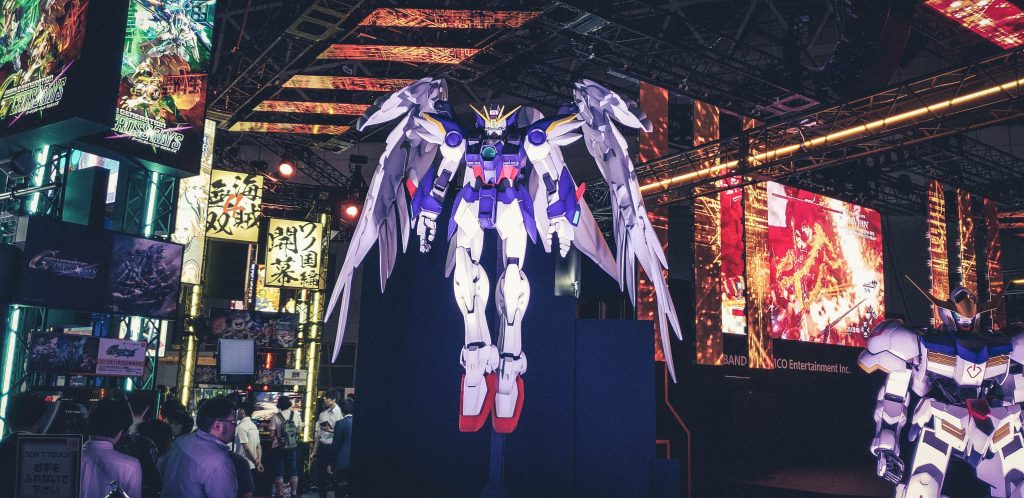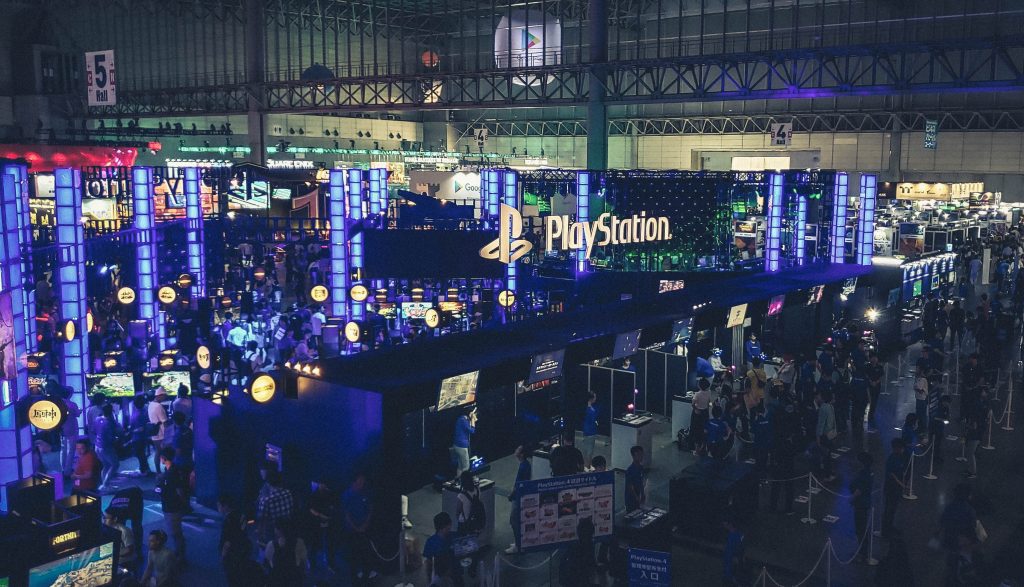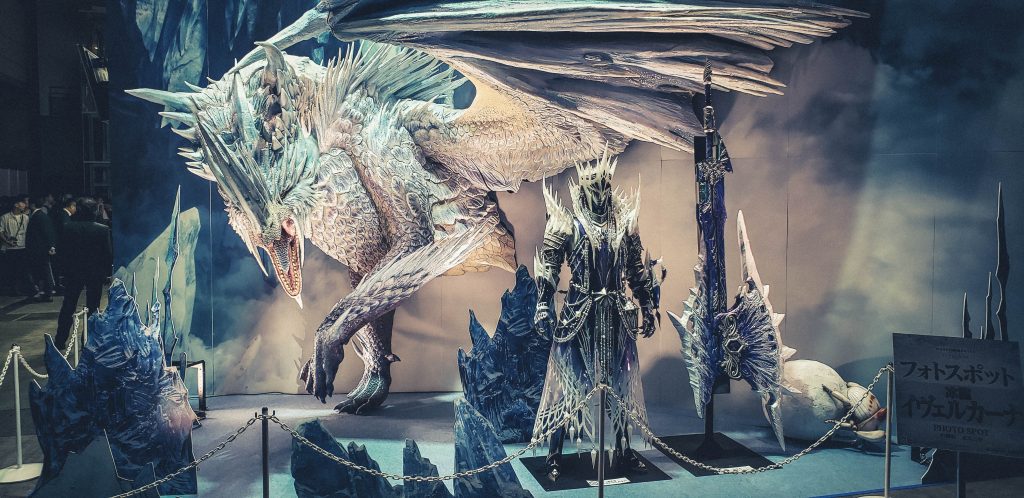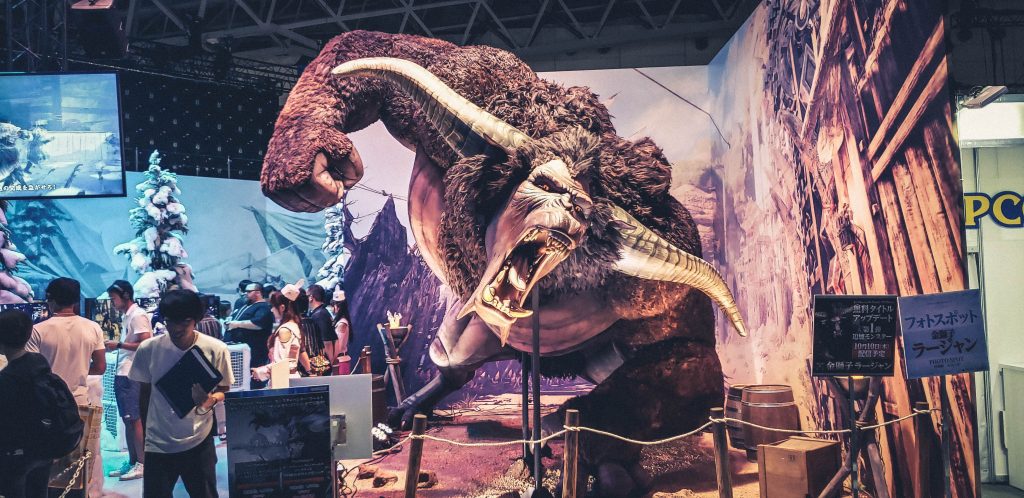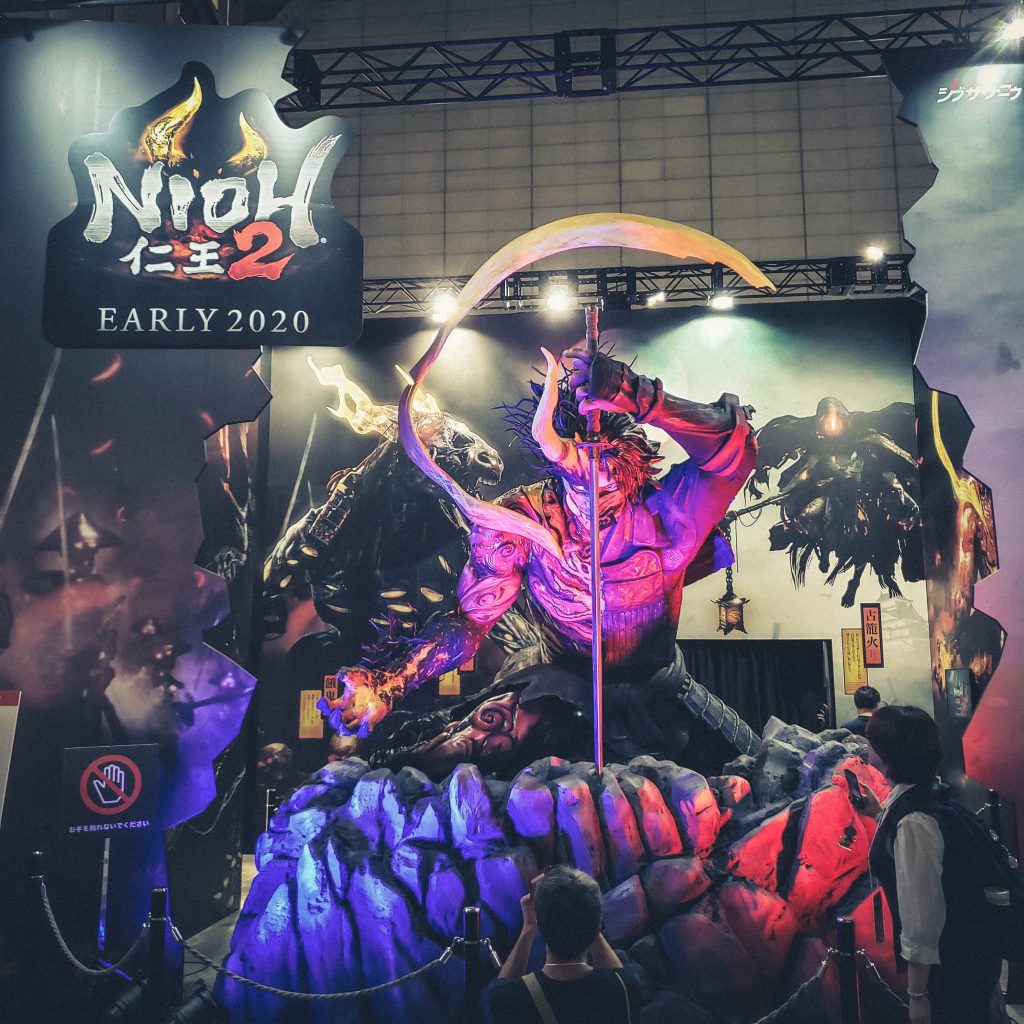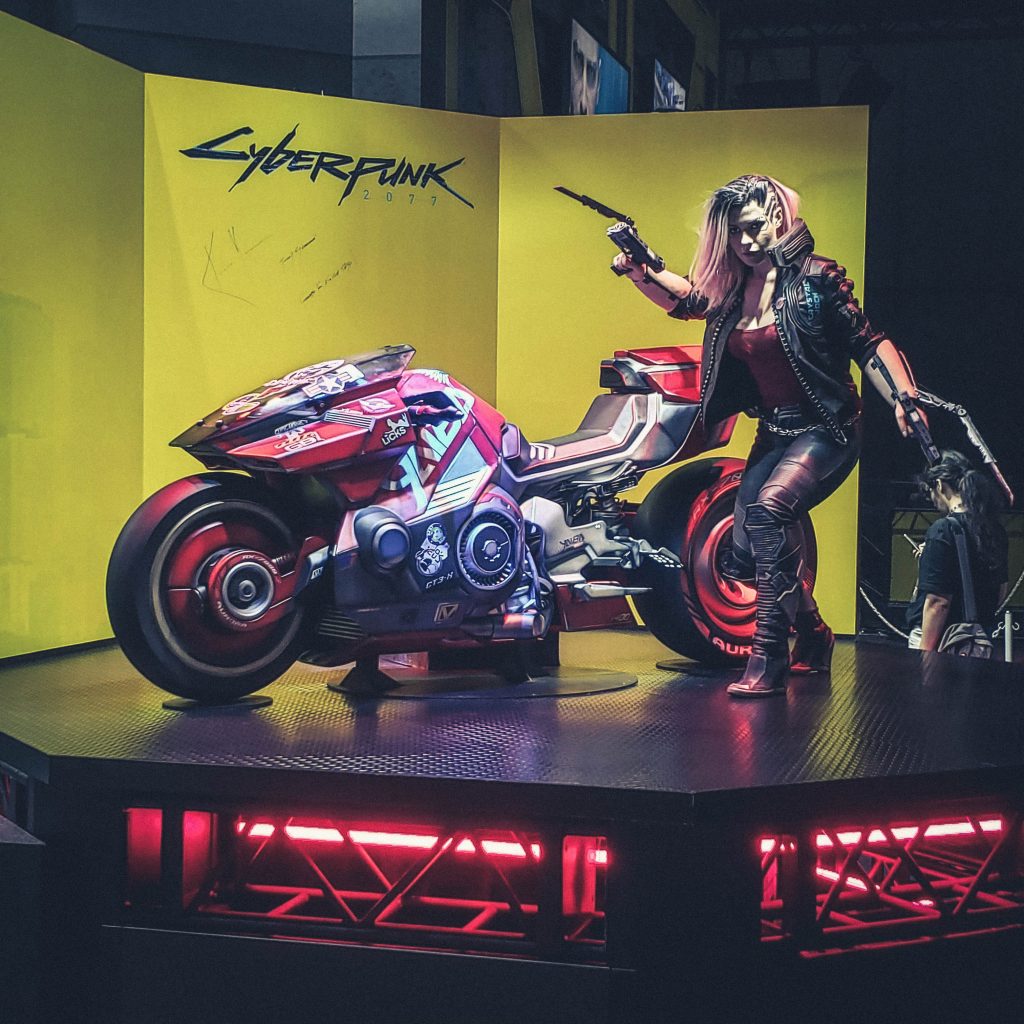This article originally featured in the November 2019 issue of Connect.
Nathan Post (Gunma)
Ahead of me an enormous frost dragon roared behind a man in glittering armor. To my right, two women were fanning themselves with cash from a bathtub full of money. To my left, a man posed with a sword taller than he was. Behind me, two robots loomed high over their surroundings. And all around me were the sights and sounds of the 2019 Tokyo Game Show.
If you’re not familiar with the event, TGS is an annual trade show that plays host to the world’s biggest video game companies, as well as a plethora of independent games and developers, as they come together to show off the newest titles and innovations in the industry to each other, the press, and the public.
The show takes place over four days every September at Makuhari Messe, near Kaihin Makuhari Station in Tokyo. It is open exclusively to industry insiders on the first two days, and then to the public on the following two. This year the show ran from 10:00 a.m. to 5:00 p.m. each day with an admission fee of 2000 yen for the public.
If you’ve never been to TGS, it’s hard to fully comprehend the levels of insanity, passion, and money that surround the event each year. This year, the show attracted more than 260,000 people over its four days. That translates to huge crowds, massive displays, and hundreds of millions of yen spent vying for your attention.
This year’s show included some of the biggest upcoming titles of 2019 and 2020, including Final Fantasy VII Remake, Cyberpunk 2077, Marvel’s Avengers, Death Stranding, and more. There was also a greater emphasis this year on VR developments, with one of the show’s eleven(!) event halls dedicated solely to VR and AR gaming.
Most Anticipated Games
Final Fantasy VII Remake
Judging from my talks with guests on the show floor and the imposing multi-hour line, the biggest thing at the show this year had to be the Final Fantasy VII Remake demo.
Final Fantasy developer Square Enix’s booth dominated the main hall, with much of it dedicated to this game. Unlike previous Final Fantasy remasters and definitive editions, Final Fantasy VII Remake is a complete reconstruction of the original from the ground up. Fans have been begging for this game for well over a decade and Square has finally responded with a stunner of a title.
Gone are the 1998 original’s PS1-era chibi block characters and pre-rendered 2D backgrounds. In their place are beautiful modern recreations of the characters and environments in full 3D, with an over-the-shoulder camera angle and realistic proportions.
Also gone are the turn-based random battles of the original. This change is sure to generate controversy among series purists, but in its place is a much more active and flashy system that incorporates elements of Kingdom Hearts and Final Fantasy XV’s real time combat systems with the ATB and menu-based systems of the original.
The TGS demo covered an early sequence of the game, where Cloud and Barret are infiltrating one of Midgar’s Mako reactors. It culminates in a boss fight against the original’s first boss, the huge robotic Guard Scorpion. The demo featured a bit of exploration and item collecting, and a lot of combat.
The changes in the combat system mark the biggest departure from the original. There are no random battles, so all enemies appear directly in the world. You can run up to them to initiate a fight with no transition to a separate battle screen. During combat, you can move around with the analogue stick to line up attacks, dodge roll with the X button, guard with the R1 button, and perform basic melee attacks with the square button.
As you fight, an ATB (active time battle) gauge fills up in the bottom-right corner, which lets you perform menu-based attacks, much like the original. Once one bar of the gauge has filled up, you can press the O button to pull up a traditional FFVII-style menu, which slows down the game to an almost-paused state. From there, you can use up an ATB segment to cast magic, which costs MP, or perform one of Cloud’s signature melee attacks like Braver.
Also carrying over from the original is the Limit Break system. Once Cloud has dealt or taken enough damage, his Limit Gauge starts flashing and allows you to perform a Limit Break attack (in the case of this demo, it was Cross Slash) to deal out heavy damage to your enemies.
And while you might think the shift to a 3D action style would limit player control only to Cloud, Barret was also playable in the demo. You can switch control between party members at any time during combat with up and down on the D-pad, or choose commands for them by pressing L2 or R2 while in the combat menu.
Barret had access to the same basic actions as Cloud, though instead of sword attacks, his basic square attack unleashes a hail of bullets from his gun arm. He also has access to his own range of special attacks, magic, and a limit break in his combat menu.
The battle against the Guard Scorpion was significantly more climactic than in the original, featuring cinematic changes in camera angle, back-and-forth dialogue between Cloud and Barret during the fight, huge barrages of rockets and gunfire, and of course, fully voiced cutscenes on either side of the fight.
The game is sure to prove controversial, as remakes of cultural touchstones often do, but judging from my hands-on time with the demo, it looks to be channeling the Lifestream of the original while successfully adapting it to the modern age. The first part of Final Fantasy VII Remake’s episodic release launches on PS4 on March 3, 2020.
Death Stranding
One of the only games at the show to stand toe-to-toe in hype with Final Fantasy VII Remake was gaming visionary Hideo Kojima’s first new game since his departure from Konami: Death Stranding.
This game has drawn reactions of astonishment and bewilderment basically nonstop since it was announced back in 2016. It features the likenesses of Guillermo del Toro, Mads Mikkelsen, and Norman Reedus, as Reedus’ character Sam treks across post-apocalyptic America carrying a baby in an amniotic sack, fending off some sort of mysterious rain ghosts. If you’ve been following this game, you know I’m not making this up.
Up until this point, no one was particularly sure what this game would even be. Kojima is well known for his beloved stealth-action series Metal Gear Solid, but the sparse gameplay clips of Death Stranding had so far only shown Sam walking along valleys, extending robo-ladders from his backpack to climb cliffs, and cautiously avoiding . . . the rain?
At this year’s show, however, Kojima gave an hour-long stage demo of the game and, after watching it, I can finally say I think I know what it is. And what it is is very strange.
The presentation starts with some typical Kojima weirdness as Sam wakes up from a nap on the ground, unzips his pants, and starts peeing away from the camera. A meter pops up beside him showing his bladder’s contents in milliliters quickly decreasing. Sam continues like this for 20 seconds or so, aiming the stream around in various directions until his bladderometer reaches zero. The realism of today’s games truly is awe-inspiring.
Next, Kojima showed Sam carrying supplies across the wilderness. But there is much more to this act in terms of game mechanics than you would expect. Every piece of gear you give Sam to carry adds to a weight total, and shows up physically as another item on his back. If you stack them poorly, Sam’s center of balance (shown by a faint yellow circle under him), will be thrown off and it will be difficult to move and balance.
Balance is an important part of the game, it seems. The L and R buttons are dedicated to controlling Sam’s balance as he moves across the terrain. You have a variety of sensors to show you how treacherous different terrain is, from the steepness of slopes to the depth of rivers. If Sam stumbles or falls, his supplies can be damaged or lost.
Kojima pauses to talk about what the “stranding” in the game’s title means. First, it implies the solitude of being “stranded.” Sam is alone throughout much of his adventure except for holograms, and of course his amniotic baby companion BB.
However, “stranding” also refers to each player’s game world as one unique “strand” of a larger thread. And those strands can cross over. Kojima reveals the game will feature passive multiplayer features, somewhat similar to those of games like Dark Souls or No Man’s Sky. As you connect different geographical regions to an in-game network, you begin to see traces of other players’ Sams, like their footsteps, paths through the world, rest points, and most importantly, items.
You can use things left behind by other players, like their ladders, shelters, and equipment. And of course you can also craft and leave things behind for them. You can even give other players “Likes” for the things they’ve left. Kojima reiterates these separate yet connected game instances are the titular “strands” of Death Stranding.
The demo continues, and at one point Sam receives a harmonica for delivering some goods. He stops to rest and changes his shoes, massages his shoulders, and plays the harmonica for BB. This is all done through the player’s input rather than through a scripted cutscene. BB reacts positively to Sam’s harmonica playing and bestows him with a few Likes.
Something more akin to a traditional Metal Gear Solid game finally appears as Sam encounters a camp of “Mules,” enemies who will try to steal your cargo (though not actually try to kill you). They have amassed a sizable collection of cargo in their camp taken from other players’ Sams.
Our Sam proceeds to approach the Mules’ camp in a freeform stealth sequence reminiscent of Metal Gear Solid V. He is eventually spotted and the Mules attack with shock spears. Sam equips an electric bola gun and stuns a few Mules before stealing a truck and driving off.
We also got a closer look at the rain ghosts seen in previous trailers, or “BTs” as they are properly known. Sam sneaks through an abandoned town area, trying to avoid some of the floating shadowy creatures, but is eventually spotted. He is pulled through a mass of tar in the ground and ends up fighting a massive four-legged BT with the bola gun from before. He infuses the gun with his blood and dirty shower water to power it up. Once again, I’m not making this up.
Sam eventually runs out of ammo, but as things begin to look dire, he calls for help from . . . other players! A few Sams from other players’ worlds appear to help turn the tide of the fight. Though it appears their participation could be limited to just cheering him on and tossing him items, rather than full-blown co-op combat. We’ll have to wait for more information on that particular element.
As the demo wraps up, Kojima talks more in depth about the kind of cooperative creation available in the world. It seems that crafting is not limited to just gear and items, or even vehicles like trucks and motorcycles. You can actually build bridges, roads, and structures by yourself or with other players, and have those structures show up in everyone’s game worlds, adorned with the name of whomever contributed to that project the most.
I walked away from this Death Stranding presentation with more answers than questions for once, which was certainly nice. The game seems to be a mix of heavy world exploration a la Zelda: Breath of the Wild, with occasional stealth and combat mechanics from Metal Gear, and held together by a shared world multiplayer system like that of Dark Souls or No Man’s Sky—all under the roof of typical Kojima political intrigue and supernatural weirdness.
Judging from this TGS demo, Death Stranding is shaping up to be one of the most interesting titles of the year. And best of all, it’s out quite soon. Death Stranding will be released exclusively for the PS4 on November 8th.
Other Games to Watch Out For
Here are some quick one sentence rundowns of seven other titles to look out for.
Cyberpunk 2077: The team behind The Witcher series tackles cyber future tech in this upcoming action RPG.
Persona 5 Royal: An overhauled version of one of 2017’s best JRPGs, featuring new stories, characters, bosses, and Personas.
Nioh 2: A follow-up to 2017’s “like Dark Souls but with samurais” title by the team behind Ninja Gaiden.
Marvel’s Avengers: A co-op RPG-lite action game with a persistent and evolving world in the style of Destiny, but for your favorite Marvel heroes.
Project Resistance: A 4 vs 1 multiplayer title set in the Resident Evil universe, where four survivors work to outmaneuver a fifth player playing as a boss monster.
Dragon Ball Z Kakarot: The newest Dragon Ball title takes cues from more traditional RPGs and features expansive zones to explore and secrets to discover in addition to its trademark anime action.
Code Vein: This Dark Souls-inspired game combines a stark anime style with a gothic world of blood and vampires.
VR Highlights
There was an especially big focus on virtual reality (VR) at this year’s show, and while there may not have been as many big-name VR titles as previous years, the variety of indie titles—and especially hardware innovations—more than made up for it. I saw games using body harnesses, cyber shoes, impact vests, moving chairs, and yes, even smell-o-vision.
TACTSUIT
The bHaptics “TACTSUIT” comprises a vest, wristbands, gloves, and ankle bands which all wirelessly interface with select games. The game on display with the suit was a simple cartoonish wild-west shooter. The gimmick here is that you can actually feel the impact of the shots when you’re hit. And no, it doesn’t hurt. It felt similar to the rumble you would feel from a normal game controller, but localized to different parts of your chest and back. The wristbands also rumbled to signify firing your pistols, but it didn’t do much to replicate the kickback of firing a gun in your hand. It was a cool demonstration of the tech that, while expensive, certainly helps immerse you in VR. It probably won’t become a staple of home VR setups, but makes sense for Japan’s increasingly popular VR arcades.
Cybershoes
Another VR accessory that elicited more than a few smiles and laughs from the passing attendees was Cybershoes’, well, cyber shoes. These sandal-like contraptions strapped over your shoes and had what appeared to be small rollers on the bottom to track movement. The game on display was Skyrim VR on PC. Guests would sit in a swiveling chair with the shoes and headset, and then take their first awkward shuffles into the world of Skyrim. Walking while sitting is probably not an action most of us are familiar with. Even so, seeing these first forays into tackling the problem of movement in VR space was impressive.
KAT Walk mini
One other solution to the problem of movement in VR was presented in KAT VR’s KAT Walk mini. This VR station is a platform about the size of a piece of gym equipment with a waist harness to hold you steady as you walk in place on a concave surface.
The demo featured a realistic VR shooting game controlled with the KAT Walk mini and a gun controller. I didn’t get a chance to try it for myself, but the people who did wait in line for the chance were standing, turning, looking, aiming, and (kind of) walking physically while in VR.
The KAT VR mini also seemed to be using a sort of sock-shuffling technique for VR walking, where the players would slide their feet across the concave surface of the platform and shuffle-walk in place to move. Again, it’s not ideal, but these kinds of first shuffle-steps are good to see.
Ambiotherm
One of the craziest demos on display in the VR booth was Keio-NUS CUTE Center’s The Lost Foxfire, featuring honest to goodness Smell-o-Vision (or “Ambiotherm,” as they called it). In the game, a fox spirit is running amok around your house and you have to chase it down and put it out with a fire extinguisher. As one tends to do.
The only problem is the fox can split into multiple identical spirits with no visual indication of which is the real one. The only way to tell the target apart is by smell. If you’re focusing on the right spirit, you’ll know by a bit of sweet warm air generated by the Ambiotherm apparatus on the headset.
The game itself was rather simple, but the technology on display was anything but. Chasing after the smells of fox spirits with motion controls in virtual reality was easily the most disembodied I felt at TGS this year.
Indie Game Awards
Sense of Wonder Night is an award-show-like event held after the second TGS business day, meant to highlight a select few indie games that inspire “a sense of wonder” in those who see them. These were all games and projects worked on by small teams of just a few people, many of whom are still in school. Here are three of the projects that inspired the greatest “sense of wonder” in me.
Uplight
While many of the games featured at Sense of Wonder Night broke conventions through unique gameplay ideas, Uplight was the single nominee that did so through hardware innovation.
Uplight is a handheld game system whose screen is not flat, not round, but a cube. A rotatable 3D cube sits atop a game controller, with five different faces of the cube acting as five game screens that all work together to allow you to play a game in three dimensions across its surface. (The sixth face, of course, was attached to the controller.)
The developers showed off a 3D version of arcade classic Breakout. In the Uplight version, players would still try to erase blocks from the top of the screen by bouncing a ball between them and a paddle at the bottom. However, here the ball is free to move off the edge of one screen and onto another, so as you play, you rotate the cubic display to keep the ball in view and move your paddle across the screens as well to hit it.
It was one of the most creative pieces of hardware I saw at the show, and I look forward to seeing what other applications it has.
Bravoon
Bravoon was equally creative in its twist on traditional racing games. At first glance it looks like another future-racer in the style of Wipeout or F-Zero, but its main mechanic is anything but standard. In Bravoon you’re of course trying to be the first across the finish line, avoiding obstacles and staying on the track along the way, but the trick here is that you can boost your speed by—wait for it—closing your eyes.
It uses the Xbox’s Kinect accessory and face tracking to make this happen. So it’s actually you, the physical player, closing your own eyes. And the longer your eyes are closed the faster you’ll go. Of course this sets up an obvious risk/reward mechanic of speeding you up in exchange for, well, not having any idea where you’re going. It was a really clever game and I wish I had gotten the chance to play it for myself.
Stone Story RPG
Stone Story RPG is immediately striking for its retro visual style, but this isn’t another of the neo-retro pixel art games. Stone Story RPG is done entirely in the same ASCII art style of PC games from the ‘80s like Nethack. These games were from an era before even basic 2D art in games, and so were drawn entirely with text editors. The characters, enemies, and entire world were made exclusively from periods, slashes, parentheses, and the like.
Stone Story RPG emulates this style impressively and pairs its minimalist aesthetic with minimalist yet captivating exploration and crafting gameplay. Your character moves around, collects items, and fights enemies automatically. Your role as the player is instead to make choices for your character like what items to craft, what gear to equip, and what paths to take.
This title is also the one that’s furthest on its way to being a complete and full game. Stone Story RPG is already out in early access on Steam, so give it a look if it sounds like your kind of game. And considering it went on to win the $3,000 grand prize for Game of the Show at Sense of Wonder Night, expect to hear more about it in the months to come.
Wrap Up
TGS is something every gamer should experience at least once. And if you’re already here in Japan, it’s all the easier to do. TGS 2020 will be held in Makuhari Messe in September of next year, though specific dates are yet to be determined. Judging from past years though, expect admission to be open to the public on Saturday and Sunday for a door fee of 2,000 yen or 1,500 yen if you sign up in advance online. Happy gaming!
Nathan Post is a former JET who spent 5 years as a middle school ALT in Fujioka. He’s a lifelong gamer whose favorite titles are Kingdom Hearts II, Resident Evil 4, and The Legend of Zelda: The Wind Waker. When he’s not gaming he enjoys pina coladas, getting caught in the rain, and thinking about gaming. He is currently attending language school full-time and working on breaking into Japanese-to-English game translation.





